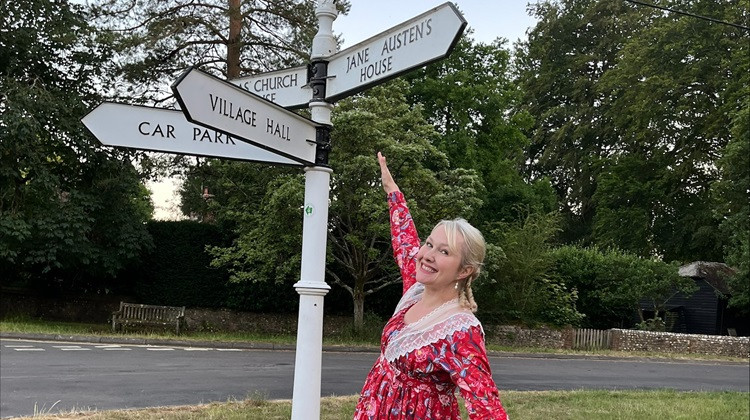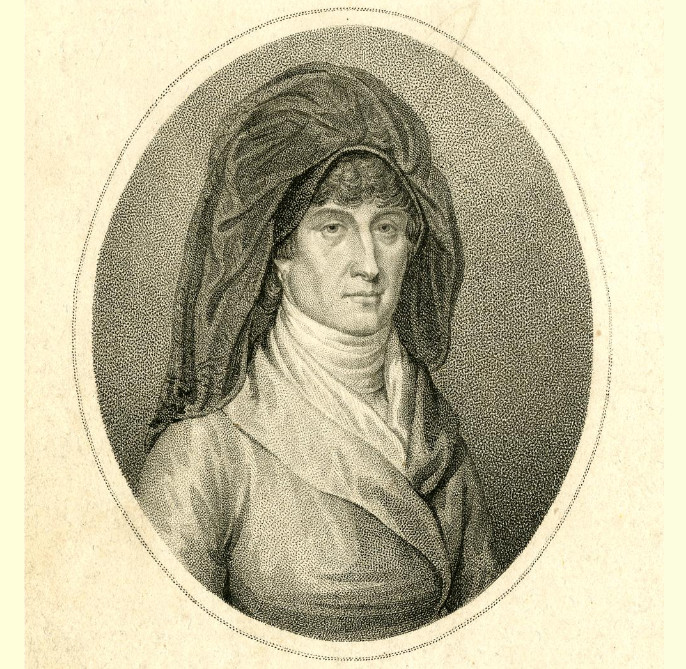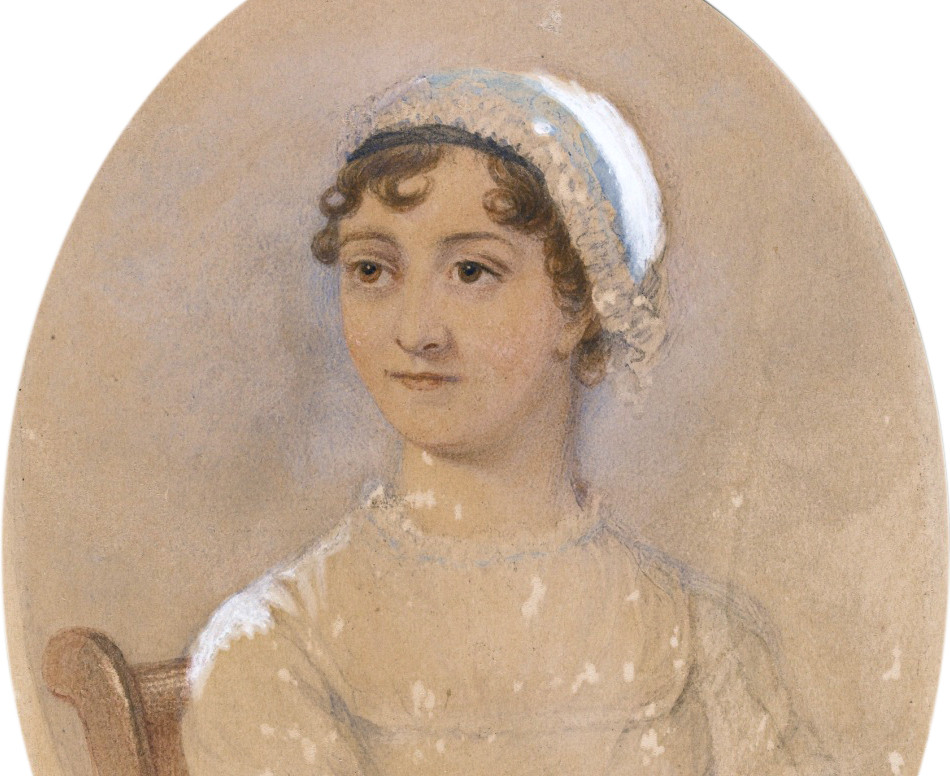
Jessica Bull has a confession. She didn’t set out to write a novel about Jane Austen. She’s been obsessed with her, though, for years — to the point that the only way to find out more about her favourite author was to bring her to life… in Jessica’s own book. Her debut novel, Miss Austen Investigates, is the result.
I must admit, I didn’t decide to write a book about Jane Austen and then carry out a meticulous plan of research; instead, I’ve been obsessed with Jane Austen for almost 30 years.
I’ve read and reread all her work, scoured every biography, watched every adaptation, visited every home she ever stayed in. I reached the point where I had so many thoughts and questions about my hero, I needed to explore them.
The answer was to bring her to life. I had a vivid impression of Austen’s character, and those of her charismatic family, from my inadvertent research. Yet I’d never found a portrayal which I felt captured the vibrant, witty, and joyfully irreverent woman I believe she was.
This is in part because, throughout her lifetime and long after her death, the Austen family were so fiercely protective of her reputation. After the vilification of other early female writers, such as Mary Wollstonecraft, who can blame them?
James Edward Austen-Leigh, Austen’s first biographer and nephew, took pains to present ‘dear Aunt Jane’ in a form palatable to his Victorian readers: the humble, dutiful, Christian spinster, who wrote for no more gratification than to amuse her family.
But Austen’s own writing tells a different story. Here is a woman bursting with ambition, bold enough to jest she will “walk the Hospitals, Enter at the Temple, or mount Guard at St James” (study medicine, law, or enlist as a soldier) if her father fails to collect her from Town.
In contrast to the moral tales of her time, Austen’s juvenilia is littered with characters who commit crimes with impunity. Her youthful novella, Lady Susan, is an unabashed examination of female wickedness.
As for sexless old maid, her letters to her sister, Cassandra, cheerfully record the author dancing and flirting with an entire a cast of dashing young men.
It was this Jane I wanted to capture and, over the series, explore how she matured into the confident, sardonic narrator of the masterpieces we know and love.
Rather than try to recreate the magic of an Austen novel (as who, apart from Austen, could ever do that?) I gave Miss Austen Investigates a modern twist by making it a murder mystery. It is my tribute to Austen’s work, in the same way Northanger Abbey is her homage to Gothic literature.
Relaying her life story as a whodunnit allows me to showcase Austen’s intelligence and passion for justice. It is fitting as her novels are essentially mysteries where the heroine must discover the true characters of those around her (think of Catherine Morland setting herself up as an amateur sleuth and accusing General Tilney of murdering his wife!)
For inspiration, I looked at crimes which touched Austen’s life. In 1799 her aunt, Mrs Leigh-Perrot, was arrested in Bath for shoplifting a card of lace worth twenty shillings – a capital crime in Georgian England. If she’d have been found guilty, the only alternative to the gallows would have been transportation.
Because of her rank and wealth, Mrs Leigh-Perrot was spared the cells and lodged with the gaoler’s family while awaiting trial. Mrs Austen offered to send Jane and Cassandra to keep her company, but Mrs Leigh-Perrot declined to allow “those Elegant young Women [to] be … inmates in a prison.”
She was eventually acquitted but it was a fraught time for the family, and it’s noticeable that Austen’s writing takes a more serious turn after this date.
To make the investigation authentic, I modelled it on the way contemporary murder cases had been handled. This led to some very amusing conversations with my editor as I had to convince her that yes, the Georgians really would have moved the body and contaminated the crime scene by inviting the entire county to view the corpse (see the Ratcliff Highway murders).
The late 18th century is the perfect time to set ‘cosy crime’, in which an amateur can triumph over the authorities, as policing was in such an embryonic stage as to make the professionals equally hopeless.
From the start, there was one member of the Austen family I was determined to include. Jane’s brother, George Austen, had learning difficulties and suffered from epilepsy. He has traditionally been excluded from the narrative, with one family biographer going so far as to state Austen was one of seven, rather than eight, children.
But, at a time when vulnerable people were routinely consigned to institutions, George was protected. He was cared for by a local family alongside his uncle, Thomas Leigh, who had similar challenges. After their father died, the Austen brothers continued to pay for his care. He lived into his 70s and on his death certificate he’s recorded as ‘a gentleman’.
While George never resided permanently with his parents at Steventon Rectory, I don’t believe we should take this as proof he was ostracised. The Georgians didn’t have the same notions of family as we do, and children were regularly sent away to be cared for by professionals.
The family themselves took in schoolboys, Austen’s sailor brothers went off to the Royal Naval Academy at 11 and 12, and the girls were sent to sent to boarding school when Cassandra was ten and Austen was only seven (with disastrous consequences after she contracted typhus and nearly died).
There’s no mention of George in his sister’s correspondence, but only a tiny proportion (161 out of an estimated 3,000) of Austen’s letters survive. He is alluded to in his parent’s papers and there’s one particularly moving passage where his father, reflecting on his son’s condition, writes: “we have this comfort, [George] cannot be a bad or wicked child.”
And so, with the terrible imagination of a novelist, I wondered if I took George, this most vulnerable and beloved member of the Austen family, and put him in the same position Mrs Leigh-Perrot was in, would it be enough to spur my Jane into solving her first mystery?
I certainly think so. And, while I’d caution my readers to remember that Miss Austen Investigates is fiction, I’m confident that if the real Jane Austen had ever had cause to apply her skills in this way, she would have been a great proficient.
Miss Austen Investigates by Jessica Bull is published on 25 January, 2024.
Find out more about this book.
Jessica lives in South East London with her husband and two daughters. A former librarian and communications consultant, she studied English literature at Bristol University and information science at City, University of London. Miss Austen Investigates is her debut novel.
Images:
- Jessica Bull at a signpost to Jane Austen’s house: supplied by the author
- James Edward Austen-Leigh, Jane’s brother 1860s: Wikimedia (public domain)
- Catherine Morland scaring herself by reading The Mysteries of Udolpho, 1833 Bentley edition of Jane Austen’s novels: Wikimedia (public domain)
- Jane Leigh-Perrott from the Lady’s Magazine, May, 1800: © The Trustees of the British Museum
- Jane Austen by James Andrews, based on the portrait by her sister Cassandra, before 1870: Wikimedia (public domain)









